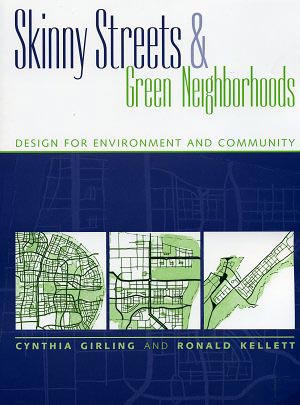Book Review: Skinny Streets and Green Neighborhoods: Design for Environment and Community
Cynthia Girling and Ronald Kellett. (2005). Washington, DC: Island Press. Paperback. 354 pp. ISBN: 15559633379.

Skinny Streets and Green Neighborhoods is the eye-catching title of an extremely engaging new book about urban planning and ecology. It approaches urban design and "place-making" at the neighborhood scale by focusing on spatial patterns of green (natural) and gray (built) elements. The authors' goals are clear: to achieve both compactness and ecological soundness in North American urban design.
Skinny Streets prefaces its design chapters with the now familiar story of post-WWII suburbanization and car-induced sprawl, and the ecological and human harm they have caused. In contrast to the prevailing trends, green neighborhoods are described as those whose density, diversity, and layouts encourage walking and reduced car usage. These neighborhoods, which contrast sharply with those in low-density suburbia, are the basic unit of urban development.
Ten exceptionally well-illustrated case studies of neighborhoods in Canada and the U.S follow: two historic and eight contemporary. Each case is presented as a study in three layers: green network, gray network, and gray fabric. The study of green/gray spatial patterns is accompanied by land-use color transparencies, overlaid on satellite images showing the study area in context. Well-placed, matching bar graphs quantify the details of land use and support the spatial graphics, while pictures and text tie spatial and quantitative data together.
The next three chapters elaborate on the green and gray design layers of the case studies. "Green Networks" discusses urban ecological structure and multiscale planning for incorporating natural processes as part of the urban design, and for the restoration and repair of fragmented ecological elements.
"Gray Networks" focuses on roads and road patterns, discussing the merits of grid and lollipop patterns, as well as the consequences of storm-water runoff from paved surfaces. Design strategies aim for pedestrian functionality but also for streets that are beautiful and environmentally sound—tree-canopied, vegetation-lined, and bioswaled. "Gray Fabric" reviews historical and contemporary theories of neighborhood design, discussing density, transit-oriented development, and placement of commercial areas near enough to high-rise and low-rise residential areas so that "it's too close to drive."
"Green Fabric" and "Urban Water" are the two remaining design chapters. "Green Fabric" focuses on the urban forest, particularly on trees. Trees act as habitat for birds and small animals, definers of urban space, and rainwater diffusers, and they create cooling canopies in summer. "Urban Water" defines water comprehensively as all the water that exists in the city, from rain to runoff to wastewater. The interruption of the hydrologic cycle begins with impervious surfaces that lead storm water and pollution to rivers, streams, lakes, and wetlands. The emphasis here is on restoring a more natural hydrologic cycle at many levels, and making water a visible rather than a hidden element of the urban landscape.
The book ends with an excellent essay on the state of green/gray design today, and what is needed to make dense, green neighborhoods with walkable streets the norm rather than the exception. It may surprise laypeople to learn that planning for green networks alongside gray networks is not standard practice in most communities. These and other reflections are well worth a close reading.
Skinny Streets teaches without preaching. Design across multiple scales (from individual city lots to regional plans)—a hard concept to convey in words alone—is illustrated on the first page of each of the six design chapters. The cultural landscape is not discussed explicitly; rather it is woven into gray fabric design through focusing on key civic buildings, and it is related to urban water by the inclusion of fountains and water sculptures. Skinny Streets maintains its focus on a design framework of green and gray spatial patterns. By limiting some discussions to key elements such as the urban forest and roads, it achieves its core purpose without getting lost in interesting but distracting side discussions of specific vegetation types, other utility corridors, or political and sociological factors. These pedagogical choices are well matched to the purpose and scope of this book. There is also an excellent bibliography for readers interested in more investigation and detail.
One criticism relates to the endnote section, which could have been more descriptive. For example, it would have appropriate for the authors to clarify over which area—metropolitan or core—the relative population densities of New York, Boston, Vancouver, and Amsterdam were calculated in each case study, so that comparisons were more clear.
Skinny Streets is an extremely well-written, well-organized, and coherent book that delivers just enough history, theory, and example at an absorbable pace. Balanced and sensible, it is likely to provoke citizens, developers, planners, and elected officials to reflect more thoughtfully on new designs and projects in their neighborhoods, cities, and regions. Hopefully, it will persuade them to frame their analyses in layers of green and gray.
Carmela Canzonieri
Faculty of Environmental Studies
York University, Toronto
